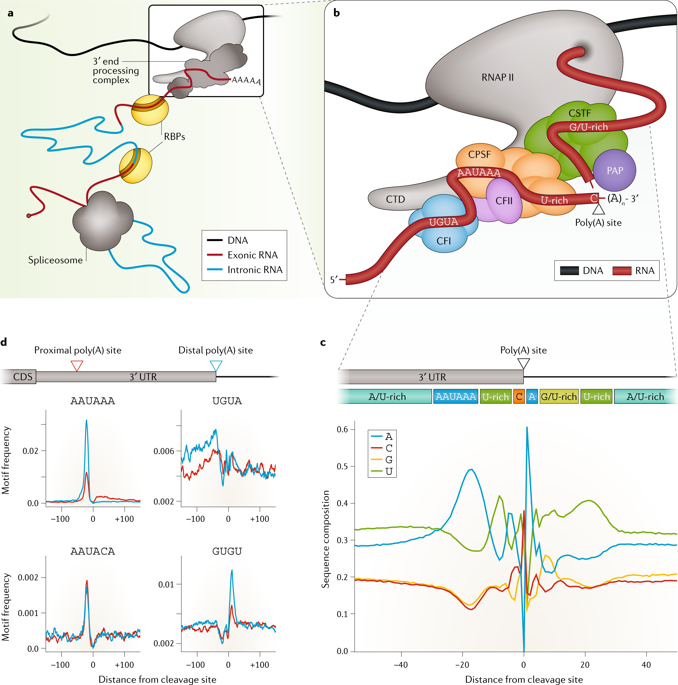当前位置:
X-MOL 学术
›
Nat. Rev. Genet.
›
论文详情
Our official English website, www.x-mol.net, welcomes your
feedback! (Note: you will need to create a separate account there.)
Alternative cleavage and polyadenylation in health and disease.
Nature Reviews Genetics ( IF 39.1 ) Pub Date : 2019-07-02 , DOI: 10.1038/s41576-019-0145-z Andreas J Gruber 1 , Mihaela Zavolan 2
Nature Reviews Genetics ( IF 39.1 ) Pub Date : 2019-07-02 , DOI: 10.1038/s41576-019-0145-z Andreas J Gruber 1 , Mihaela Zavolan 2
Affiliation

|
Most human genes have multiple sites at which RNA 3' end cleavage and polyadenylation can occur, enabling the expression of distinct transcript isoforms under different conditions. Novel methods to sequence RNA 3' ends have generated comprehensive catalogues of polyadenylation (poly(A)) sites; their analysis using innovative computational methods has revealed how poly(A) site choice is regulated by core RNA 3' end processing factors, such as cleavage factor I and cleavage and polyadenylation specificity factor, as well as by other RNA-binding proteins, particularly splicing factors. Here, we review the experimental and computational methods that have enabled the global mapping of mRNA and of long non-coding RNA 3' ends, quantification of the resulting isoforms and the discovery of regulators of alternative cleavage and polyadenylation (APA). We highlight the different types of APA-derived isoforms and their functional differences, and illustrate how APA contributes to human diseases, including cancer and haematological, immunological and neurological diseases.
中文翻译:

健康和疾病中的替代切割和多聚腺苷酸化。
大多数人类基因具有多个位点,在这些位点上可以发生 RNA 3' 末端切割和多聚腺苷酸化,从而能够在不同条件下表达不同的转录亚型。对 RNA 3' 末端进行测序的新方法已经生成了全面的多腺苷酸化 (poly(A)) 位点目录;他们使用创新的计算方法进行的分析揭示了 poly(A) 位点选择如何受核心 RNA 3' 末端加工因子(如切割因子 I 和切割和多腺苷酸化特异性因子)以及其他 RNA 结合蛋白(尤其是剪接)调节因素。在这里,我们回顾了使 mRNA 和长非编码 RNA 3' 末端的全局映射成为可能的实验和计算方法,对产生的异构体进行量化,并发现选择性切割和多聚腺苷酸化 (APA) 的调节剂。我们重点介绍了不同类型的 APA 衍生异构体及其功能差异,并说明 APA 如何导致人类疾病,包括癌症和血液、免疫和神经系统疾病。
更新日期:2019-11-18
中文翻译:

健康和疾病中的替代切割和多聚腺苷酸化。
大多数人类基因具有多个位点,在这些位点上可以发生 RNA 3' 末端切割和多聚腺苷酸化,从而能够在不同条件下表达不同的转录亚型。对 RNA 3' 末端进行测序的新方法已经生成了全面的多腺苷酸化 (poly(A)) 位点目录;他们使用创新的计算方法进行的分析揭示了 poly(A) 位点选择如何受核心 RNA 3' 末端加工因子(如切割因子 I 和切割和多腺苷酸化特异性因子)以及其他 RNA 结合蛋白(尤其是剪接)调节因素。在这里,我们回顾了使 mRNA 和长非编码 RNA 3' 末端的全局映射成为可能的实验和计算方法,对产生的异构体进行量化,并发现选择性切割和多聚腺苷酸化 (APA) 的调节剂。我们重点介绍了不同类型的 APA 衍生异构体及其功能差异,并说明 APA 如何导致人类疾病,包括癌症和血液、免疫和神经系统疾病。











































 京公网安备 11010802027423号
京公网安备 11010802027423号